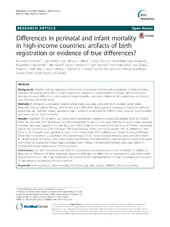| dc.description.abstract | Background: Variation in birth registration criteria may compromise international comparisons of fetal and infant mortality. We examined the effect of birth registration practices on fetal and infant mortality rates to determine whether observed differences in perinatal and infant mortality rates were artifacts of birth registration or reflected true differences in health status. Methods: A retrospective population-based cohort study was done using data from Canada, United States, Denmark, Finland, Iceland, Norway, and Sweden from 1995–2005. Main outcome measures included live births by gestational age and birth weight; gestational age—and birth weight-specific stillbirth rates; neonatal, post-neonatal, and cause-specific infant mortality. Results: Proportion of live births <22 weeks varied substantially: Sweden (not reported), Iceland (0.00 %), Finland (0.001 %), Denmark (0.01 %), Norway (0.02 %), Canada (0.07 %) and United States (0.08 %). At 22–23 weeks, neonatal mortality rates were highest in Canada (892.2 per 1000 live births), Denmark (879.3) and Iceland (1000.0), moderately high in the United States (724.1), Finland (794.3) and Norway (739.0) and low in Sweden (561.2). Stillbirth:live birth ratios at 22–23 weeks were significantly lower in the United States (79.2 stillbirths per 100 live births) and Finland (90.8) than in Canada (112.1), Iceland (176.2) and Norway (173.9). Crude neonatal mortality rates were 83 % higher in Canada and 96 % higher in the United States than Finland. Neonatal mortality rates among live births ≥28 weeks were lower in Canada and United States compared with Finland. Post-neonatal mortality rates were higher in Canada and United States than in Nordic countries. Conclusions: Live birth frequencies and stillbirth and neonatal mortality patterns at the borderline of viability are likely due to differences in birth registration practices, although true differences in maternal, fetal and infant health cannot be ruled out. This study emphasises the need for further standardisations, in order to enhance the relevance of international comparisons of infant mortality. | en_US |

